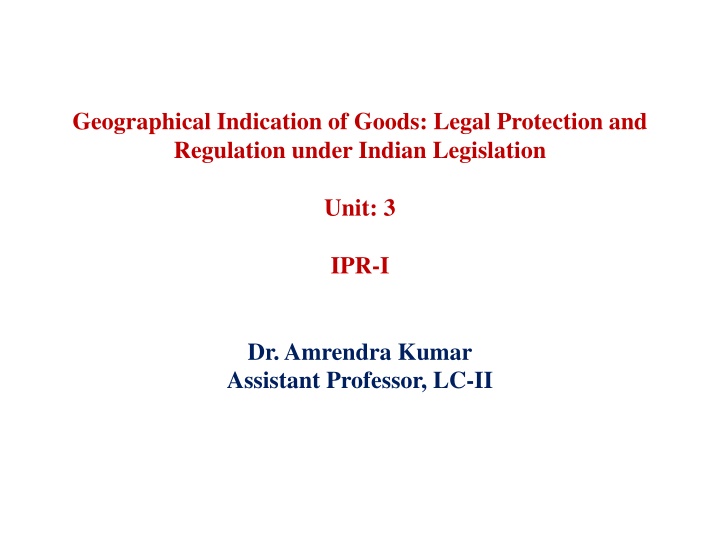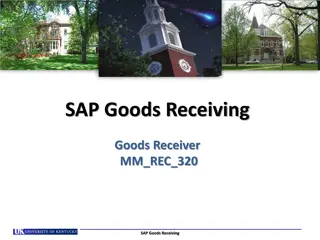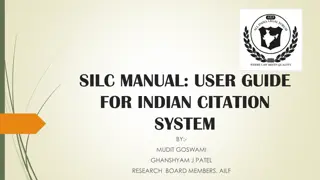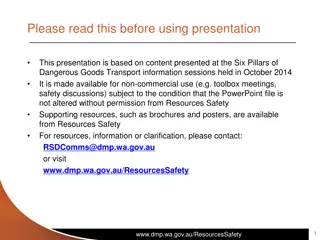Legal Protection of Geographical Indications of Goods in Indian Legislation
Geographical indications are crucial for recognizing products' origins and preserving their unique qualities. This article explores the legal framework surrounding geographical indications in India, highlighting the Geographical Indications of Goods Act, 1999. It discusses the distinction between indication of source and appellation of origin, emphasizing the significance of protecting these indications to safeguard producers' interests.
Download Presentation

Please find below an Image/Link to download the presentation.
The content on the website is provided AS IS for your information and personal use only. It may not be sold, licensed, or shared on other websites without obtaining consent from the author.If you encounter any issues during the download, it is possible that the publisher has removed the file from their server.
You are allowed to download the files provided on this website for personal or commercial use, subject to the condition that they are used lawfully. All files are the property of their respective owners.
The content on the website is provided AS IS for your information and personal use only. It may not be sold, licensed, or shared on other websites without obtaining consent from the author.
E N D
Presentation Transcript
Geographical Indication of Goods: Legal Protection and Regulation under Indian Legislation Unit: 3 IPR-I Dr. Amrendra Kumar Assistant Professor, LC-II
Introduction Generally, Geographical medications are related with the culture, geography, traditions, heritage and traditional practices of peoples and countries. The quality and genuine products having distinct characteristics originating from a particular region, have over centuries created an impact on human civilization. These identifications became so important that these regions started specializing in producing these unique products, which led to identifying such goods as originating from a particular region especially in European nations. France was the first country to afford a protection to Geographical indication through the legal instrument, the French appellation d origine controlee (AOC). This was founded on the concept of the protection of origin that was born out of the crises that rocked the French wine trade in early 20th Century. Later on, it became a important subject matter of intellectual property with wide recognition through international and regional conventions, agreements and other legal instruments time to time. As we know that TRIPs agreement under WTO is major international legal instruments dealing with all subject matters of IPRs including GIs. The concept emerged with IP law which established GIs as collective intellectual property and granted legal recognition as appellation of origin and indication of source.
Conted.. Indication of Source , refers to an indication of the origin of the product from a place or country, such as Made in India or Product of France etc. Such indications do not reflect the quality of the product, rather it merely shows its origin. In other words, indication of source is considered as any expression or sign used to indicate that the goods and services originated in country, region or locality does not guarantee the character, quality ad reputation related with such geographical indications. Appellation of Origin refers to a sign that indicates that a product originates in a specific geographic region only when the characteristic qualities of the product are due to the geographical environment, including natural and human factors. For example, if a good manufactured in India having goodwill that appellation protects such goodwill. If somebody else manufacturing goods in Canada and adds the appellation to call it Made in India ; then it would be simply misuse of the Indian appellation. Geographical Indications as being used currently includes both the above concepts and it refers to "... indications which identify a good as originating in the territory of a country, or a region or locality in that territory, where a given quality, reputation or other characteristic of the good is essentially attributable to its geographical origin." (Article 22.1 of the TRIPS Agreement)
Legal Protection under Indian Legislation India after joining as a member State of the TRIPS Agreement, It enacted sui generis legislation for the protection of Geographical Indications namely The Geographical Indications of Goods (Registration and Protection) Act, 1999 on 30 December, 1999 which came into force on 15th September, 2003; and subsequently the Geographical Indications of Goods (Registration and Protection) Rules, 2002 . The Object of the Geographical Indications of Goods (Registration and Protection) Act, 1999 is three fold: firstly by specific law governing the geographical indications of goods in the country which could adequately protect the interest of producers of such goods, secondly, to exclude unauthorized persons from misusing geographical indications and to protect consumers from deception and thirdly, to promote goods bearing Indian geographical indications in the export market. It defines Geographical Indication , in relation to goods, means an indication which identifies such goods as agricultural goods, natural goods or manufactured goods as originating, or manufactured in the territory of country, or a region or locality in that territory, where a given quality, reputation or other characteristic of such goods is essentially attributable to its geographical origin and in case where such goods are manufactured goods one of the activities of either the production or of processing or preparation of the goods concerned takes place in such territory, region or locality, as the case may be. [Section 2 (1) (e)]
Conted.. Indication includes any name, geographical or figurative representation or any combination of them conveying or suggesting the geographical origin of goods to which it applies. [Section 2 (1) (g)] Goods means any agricultural, natural or manufactured goods or any goods of handicraft or of industry and includes foodstuff. [Section 2 (1) (f)] Producer in relation to goods, means any person who: a. if such goods are agricultural goods, produces the goods and includes the person who processes or packages such goods; b. if such goods are natural goods, exploits the goods; c. if such goods are handicraft or industrial goods, makes or manufactures the goods, d. and includes any person who trades or deals in such production, exploitation, making or manufacturing, as the case may be, of the goods. [Section 2 (1) (k)] However, GIs are given to the producers or association of persons quite different with Collective marks and Certification marks dealt under the TrademarkAct, 1999. Herein, Collective mark simply distinguishes the goods of members of the associations which owns the mark for those of others as defined in Section 2(1) (g) of TM Act, 1999. On the other hand, Certification marks only certify goods in respect of quality, accuracy and other characteristics as required for the goods. It has been well defined under Section 2 (1) (e) of the TM Act, 1999. Both have as such no relation with geographical indications and attribution to the geographical origin and reputation.
GI Registrar and Registration: For the purpose of this Act, there shall be established a Registry which shall be known as the Geographical Indications Registry . Accordingly, the Geographical Indications (GI) Registry was established in Chennai (Tamilnadu). The Controller-General of Patents, Design and Trademark is designated as the Registrar of Geographical Indications. A copy of register of GI and other documents are kept under the control and management of the Registrar. [Section 5 (1)] A geographical Indication may be registered in respect of any or all of the goods, comprised in such class of goods as may be classified by the Registrar and in respect of a definite territory of a country, or a region or locality in that territory. The Registrar shall further classify the goods in accordance with the International Classification of Goods for the purpose of registration of geographical indications. [Section 8] For registration, the GI must fall within the scope of the definition of the expression geographical indication . In addition such a GI should not fall within the purview of prohibitions given as: use of which would be likely to deceive or cause confusion, or contrary to any law for the time being in force; comprises or contains scandalous or obscene matter; comprises or contains any matter likely to hurt the religious susceptibilities; determined to be generic names or indications of goods. [Section 9] A homonymous geographical Indications may be registered under this Act, if the Registrar is satisfied, after considering the practical conditions under which the homonymous indication in question shall be differentiated from other homonymous indications and the need to ensure equitable treatment of the producers of the goods concerned, that the consumers of such goods shall not be confused of mislead in consequence of such registration. [Section 10]
Procedure for Registration: [Section 11-16] Application for registration or any other documents may be filed directly in the GI Registry, Chennai, or may be sent by post or registered post or speed post or courier services. The GI Registry is situated at Geographical Indications Registry, Intellectual Property Office Building, G.S.T. Road, Guindy, Chennai 600032 having all-India Jurisdiction. Any association of persons or producers or any organization or authority established by or under any law representing the interest of the producers of the concerned goods may apply for registration of a Geographical Indication. Any such organization or association being not that of the producers may have to prove that they represent the interest of producers. The model form for filing GI Application is enclosed under GI Rules, 2001. An Indian application for the registration of a geographical indications can be made in triplicate in Form GI 1(A) for single class and in GI 1 (C) for multiple classes. A Convention Application shall be made in triplicate in Form GI 1(B) for single class and in GI 1 (D) for multiple classes. Such Application shall be signed by the applicant or his agent. On receipt of an application, the Examiner/Authorized Officer shall scrutinize the application and the accompanying Statement of Case as to whether it meets the requirements of the GI Act and the Rules. The Registrar may accept the GI Application absolutely or subject to such amendments, modification, conditions or limitations as he thinks fit.
Conted.. The Registrar of GI publishes all the GI Applications and authorized user applications in the Official GI Journal. The GI Journal is being published and is made available to the Public ordinarily in the first week of every month, through the Official Website. After advertisement of a Geographical Indication in the Geographical Indications Journal, any person may within three months oppose the registration of an application for GI. This period may be extended by a period, not exceeding one month, by making an application to the Registrar along with the prescribed fee. Such an application for extension shall be filed before the expiry of the period of three months. The Notice of Opposition shall be filed only before the Registrar of Geographical Indications. Where no Notice of Opposition is filed to an application for the registration of a geographical indication advertised or re-advertised in the Journal within the period specified or where an opposition is filed and it is dismissed and the appeal period is over, the Registrar shall, enter the geographical indication. The entry of a geographical indication in the register shall specify the date of filing of application, the actual date of the registration, the goods and the class in respect of which it is registered. The certificate of registration of a geographical indication to be issued by the Registrar shall be on Form-O2. The registration of a geographical indication shall be for a period of ten years, which may be renewed from time to time in accordance with provisions of this section. [Section 18] The registration of a geographical indication shall if valid, give exclusive right to use of GI in relation to the goods registered; and to obtain relief in respect of infringement of the GI in the manner provided by this Act. [Section 21]
Infringement, Offences and Penalties: No person shall be entitled to institute any proceeding to prevent or, to recover damages for the infringement of an unregistered geographical indication. However, the rights of action against any person for passing off goods are not affected for the remedies thereof. [Section 20] A registered geographical indication is infringed by a person who, not being an authorized user thereof: a) uses such GI by any means in the designations or presentation of goods that indicates or suggests that such goods originate in a geographical area other than the true place of origin of such goods in a manner which misleads the persons as to the geographical origin of such goods; or b) uses any GI in such manner which constitutes an act of unfair competition including passing off in respect of registered GI. However, this must be considered as per the Explanations given herein.[Section 22] In the context of offences what constitutes the meaning of applying geographical indication has been dealt with in Section 37. Section 38 list two kinds of offences namely: (a) falsifying a GI; and (b) falsely applying a GI. The penalty for falsification of GIs and the circumstances in which a person applies false GI are enumerated in Section 39. Falsely representing a GI as registered is listed in Section 42. The penalty prescribed for the offence mentioned in Section 39 is imprisonment not is less than six months which may extent to three years and with fine Rs. 50000 up to 2 lakhs. The penalty for the offence mentioned under Section 42 shall be punishable with imprisonment for a term which may extent to three years or with fine or both.
Conted. The cognizance of an offence mentioned under these sections would be taken on compliant in writing made by Registrar to Metropolitan Magistrate or Judicial Magistrate of First Class as prescribed under thisAct. [Section 50] Any suit for the infringement of a registered GI or relating to any right in a registered GI or passing off the goods, whether having registered or unregistered GI, shall be instituted in District Court having jurisdiction to try the suit. [Section 66] The relief which a district court may grant in any suit for infringement or for passing off referred in section 66 includes injunction and at the option of the plaintiff, either damages or account of profits along with delivery or destruction of the infringing goods. [Section 67] To conclude, this particular legislation adequately provides legal protection and recognition of the geographical indication of goods in India. The effective rules and guidelines issued time to time under this Act also facilitate and manage the GIs across the country. Now, the number of the GIs in relation to goods in India is increasing manifold due to awareness and effectiveness of this legislation. Thanks!























